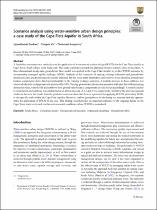| dc.contributor.author | Gxokwe, Siyamthanda | |
| dc.contributor.author | Xu, Yongxin | |
| dc.contributor.author | Kanyerere, Thokozani | |
| dc.date.accessioned | 2023-03-09T07:37:03Z | |
| dc.date.available | 2023-03-09T07:37:03Z | |
| dc.date.issued | 2020 | |
| dc.identifier.citation | Gxokwe, S. et al. (2020). Scenarios analysis using water-sensitive urban design principles: A case study of the Cape Flats Aquifer in South Africa. Hydrogeology Journal, 28 (6) ,2009-2023. https://doi.org/10.1007/s10040-020-02188-w | en_US |
| dc.identifier.issn | 1435-0157 | |
| dc.identifier.uri | https://doi.org/10.1007/s10040-020-02188-w | |
| dc.identifier.uri | http://hdl.handle.net/10566/8561 | |
| dc.description.abstract | A feasibility assessment was undertaken on the application ofwater-sensitive urban design (WSUD) for the Cape Flats Aquifer in
Cape Town, South Africa, at the local scale. The study contributes towards the planning of water-sensitive cities in the future. A
three-dimensional steady-state groundwater flow model was applied to the Cape Flats Aquifer to predict WSUD scenarios by
incorporating managed aquifer recharge (MAR). Analysis of the scenarios of varying recharge estimates and groundwater
abstraction rates, predicted using the model, indicated that the water-table distribution and outflows from identified groundwater
balance components show direct proportionality to the varying recharge scenarios. A notable increase in these outflows was
observed when the recharge rate was increased by 50%. Varying groundwater abstraction scenarios indicated that with increasing
abstraction rates, water levels and outflows fromgroundwater balance components also decreased accordingly. A notable decline
in water levels and outflows was established at an abstraction rate of 2.5 and 5 L/s, respectively. Similar to the previous regional
studies in the area, the results from the predicted scenarios show that there is a potential for applying WSUD, particularly MAR,
at site-specific scale within the Cape Flats Aquifer. However, shallow groundwater levels during wet seasons limit the opportunities
for application of WSUD in the area. This finding would provide an important reference to the ongoing debate on the
Cape Town water crisis and similar environmental conditions where WSUD is considered. | en_US |
| dc.language.iso | en | en_US |
| dc.publisher | Springer | en_US |
| dc.subject | Geology | en_US |
| dc.subject | Groundwater | en_US |
| dc.subject | Climate change | en_US |
| dc.subject | South Africa | en_US |
| dc.subject | Water pollution | en_US |
| dc.title | Scenarios analysis using water-sensitive urban design principles: A case study of the Cape Flats Aquifer in South Africa | en_US |
| dc.type | Article | en_US |

